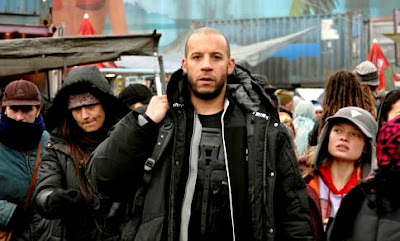Babylon A. D. and Children of Men: an 8 point comparison
 Now that the French director of Babylon A. D. Matthew Kassovitz has condemned his own work, blaming Fox’s studio intervention for the inferior product, many have gleefully starting savaging the movie. Yesterday, I saw one post already claiming that Babylon A. D. is the worst science fiction film ever made. Having seen the movie, I can safely say that there are worse, including last week’s Death Race. Babylon A. D. is badly flawed, but it keeps hinting at good intentions that went awry, and it suffers from the many comparisons it invites to Children of Men and Blade Runner. Ironically, I enjoyed
Now that the French director of Babylon A. D. Matthew Kassovitz has condemned his own work, blaming Fox’s studio intervention for the inferior product, many have gleefully starting savaging the movie. Yesterday, I saw one post already claiming that Babylon A. D. is the worst science fiction film ever made. Having seen the movie, I can safely say that there are worse, including last week’s Death Race. Babylon A. D. is badly flawed, but it keeps hinting at good intentions that went awry, and it suffers from the many comparisons it invites to Children of Men and Blade Runner. Ironically, I enjoyed Babylon A.D. was adapted from a 2001 French science fiction novel entitled Babylon Babies by Maurice G. Dantec, in which Bosnian veteran Cornelius Toorop escorts Marie Zorn from Kazakhstan to Montreal in 2013. Dantec imagines a future dominated by the complications of genetic experimentation, so Toorop has to deal with cyborgs, drug experiments, cloning, and a large artificial biosphere program when he’s not setting off grenades and defending himself against enemies.
In the movie version, much of the genetic subtext falls away, and the viewer is greeted with Vin Diesel (Toorop) strutting around a grungy
1. Children of Men takes as its premise the fact that at some point mankind stopped reproducing. Everything in the story gains urgency due to this central problem, especially Theo’s need to get pregnant Kee to safety. She represents mankind’s last hope for renewal. Babylon A. D. depicts a very similar future in which something vague is going on concerning genetics, but there’s no central conceit to focus the action. Toorop, like Theo, still must escort
2. In Children of Men, Kee (Clare-Hope Ashitey), a handsome African-British woman, spends much of the movie deciding on the name for her baby. In
3. In both films, the young woman has an older female helper, a kind of female Virgil to guide her through her respective futuristic Inferno. Kee gets some frumpy middle-aged woman with dreadlocks. Lucky
4. Children of Men keeps emphasizing how
5. Children of Men plays with the complacencies of its audience by inserting terrorist kidnappings, bombings, and Abu Ghraib-like activities in
6. Children moves toward a grim refugee camp where Theo and Kee try to survive a major battle scene. In contrast,
7. Theo is a drab (but handsome) bureaucrat who can’t find any decent shoes, so he's obliged to perform some of his heroics in flip flops. Toorop is one tough dude with an Abercrombie and Fitch build and lots of tattoos. Vin Diesel conveys world-weary macho cool to the point where he hardly speaks, and when he does, he slurs things like “Life is simple. Kill or be killed.” I would imagine that he aspires to the level of Bruce Willis as an action star, but he often reminded me of a young Sylvester Stallone with an odd hint of Adam Sandler, perhaps due to his
8. Children of Men strikes me as genuinely prophetic. In contrast, Babylon A. D. helps me appreciate the brilliance of Children of Men.


Comments
Good point about Leeloo in The Fifth Element. She does resemble Aurora in some ways. It's too bad that Kassovitz did not try to emulate The Fifth Element's slightly campy style.